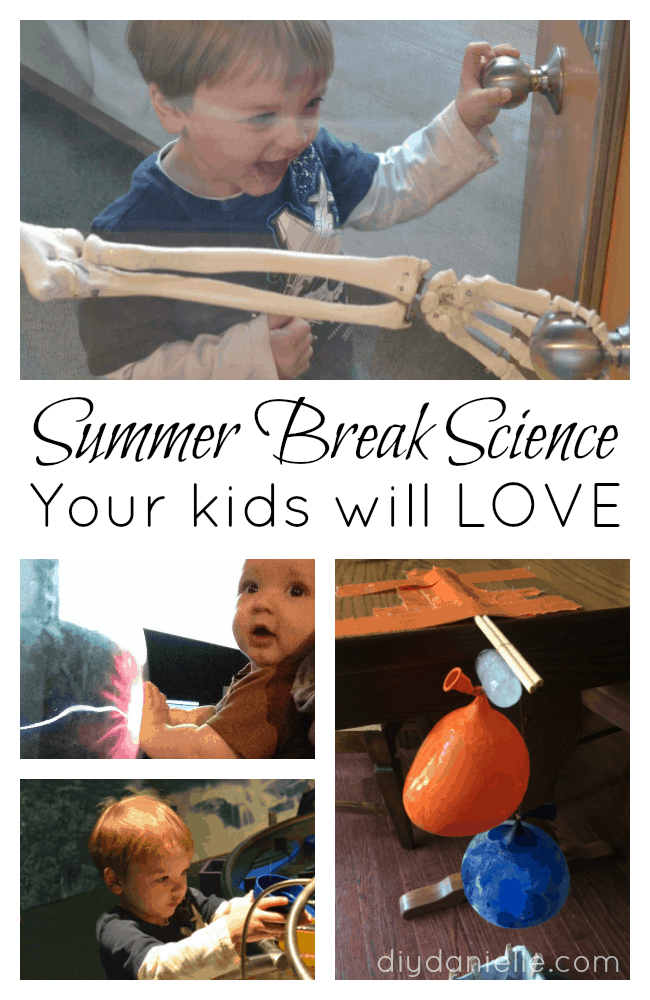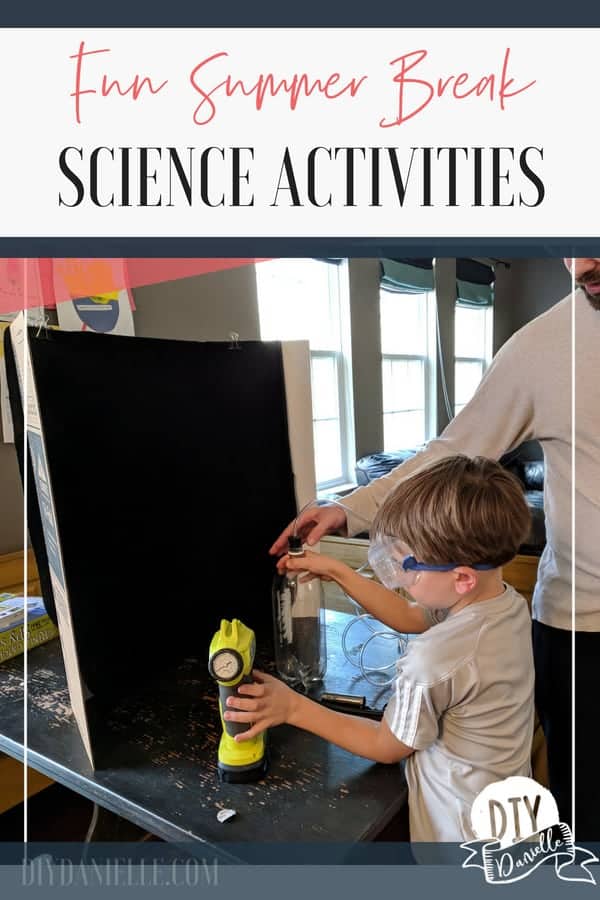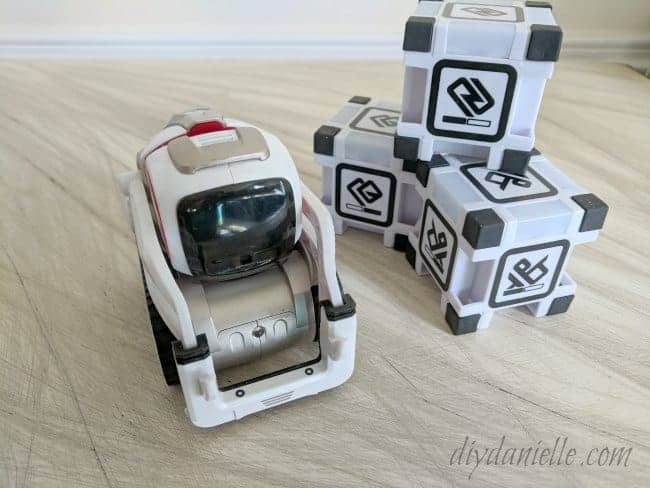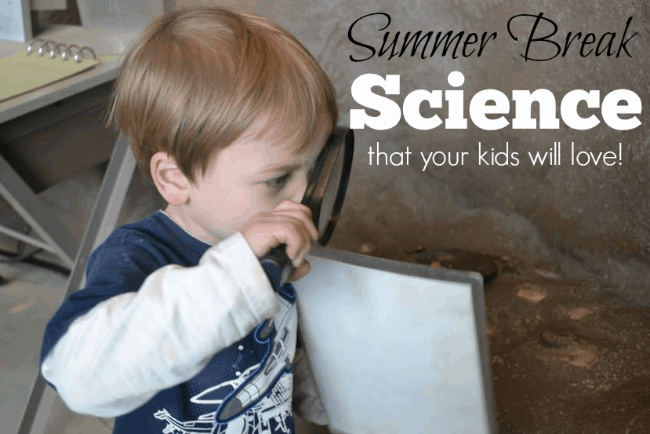
Some ideas for activities, field trips, and toys that can help promote learning over summer break. These are FUN summer break science ideas that your children will love! Avoid the summer slide!
This post may contain affiliate links. Using these links helps support my blog. Thank you!
I know many of us struggle with fears that our children will lose all they learned at school due to the dreaded summer break slide. It’s good to have some solid plans so you can do at least one educational activity each week. While my kids sometimes do an occasional summer camp, I enjoy doing summer science activities with them. I give my kids a lot of activities and toys that are meant for much older kids. We also do a lot of summer reading activities and field trips with them.
Post originally published June 2016, updated June 2018
Educational STEM Toys for Summer Break Science
Pick up some educational toys. I have younger children, but they still enjoy these toys that are rated for much older kids. We focus a lot on science because it’s something I love and enjoy doing with them.The real key with these toys is to rotate them out and limit time with them. That way they never get boring. And if you help the kids with them 1:1, then it will be even more appealing to them. My kids use Magnatiles and Legos on their own, but the other toys are ones we use with them and educate as we go along.
Here are some of our favorites:
- Snap Circuits are AMAZING. And rated for way older than 2 years old, but we got them for our oldest when he was 2 and just supervised heavily when he played with them. They have several sets so if you’ve already done the regular set too many times, you can pick up the arcade electronics, the light set, R/C Rover, motion electronics, or the Alternative Energy kit. Honestly, these are really educational. My husband is a computer and electrical engineer so it’s boring for him, but I focused more on bio and environmental science in school so this is very interesting and informative for me. I like to learn with my kids. The greatest challenge is learning with them and trying to rephrase so it’s age appropriate.
- Legos: I know, this doesn’t seem educational, but using the plans to build is a skill. It’s also quiet.
- Stem Robot Mouse Learning Activity: Don’t own this one, but adding it to our wishlist! It looks really neat.
- Cozmo: My 6 year old loves working on programming skills using his Cozmo robot. My 4 year old happily watches and observes.
- Learning Resources, Gears: We have something similar and the kids enjoy this!
- Microscope: Pick up a microscope for investigating new things at home. We have a really cool one but it’s older and they don’t seem to be producing it anymore.
- Telescope: We love to check out the stars and planets with our telescope. This is good if you let your kids stay up late. If you don’t want to buy one, you can check to see if there are local events for kids to star gaze. My husband has requested the one I linked after doing a LOT of research… it’s expensive, but there are more affordable telescopes as well.
- Magnatiles or something similar. We really like this set, “PlayMags,” because they’re a bit cheaper and have a LOT of different fun options for variety of pieces. It’s easy to make little Magnatile take a long kits if you use a metal lunchbox. These are great for summer trips to the beach or camping.

Having a water table or a sandbox? They’re toys, but they’re also learning toys. Build a sandbox, add shade to your sandbox to protect the kids from the hot sun, add details that encourage pretend play to your playhouse, and find a water table you love.
Summer Break Science: Educational Activities
- Sign up for the Groovy Lab Box for the summer (or beyond)! This is SO much fun. We received one to review and it’s something I may buy my oldest for his 5th birthday because he LOVES science activities. My 2 year old was too young for it, but my 4 year old really enjoyed it. It’s intended for older kids (8+), but I helped him with it so it worked for us.Getting it addressed to your child, then sitting down to work on it with them each month will help make this a really fun option for them. Because it’s mailed monthly, it will keep you on track too.This setup includes a lab book with reading about the topic and places to answer questions related to the lab. This teaches organization in science- which if you’re ever done science, you know this is a VERY important skill.Here’s a video of us playing with the lab:
- YouTube: Yes, it’s electronics and we “don’t want to have our kids sitting on a device all day” but I want to remind you- electronics can be HELPFUL. Educational. It’s all about how you use them. If my kids have a question, we look it up. If I think of something interesting, we look it up. There are some really neat YouTube channels that are educational. There are a few that show awesome science experiments…. we watch them and sometimes do them ourselves at home. So. Much. Fun. And it doesn’t NEED to be “made” for kids… my kids enjoy videos intended for grownups too.Here are some good channels:
- Cook: This isn’t only a life skill, but it’s also important to teach kids how to follow a recipe (instructions) on how to make something, as well as how to measure things. You could even let them mess up the measurements and learn the hard way what happens when you don’t measure properly… too much salt in your cookies and they certainly won’t be the delicious treat you were hoping for. Talk about and look up how different amounts of ingredients can effect the taste and texture of the item, as well as how to substitute some items if you don’t have them. Make stuff from scratch- ie. mix your own chili powder or taco seasoning. Teach them how to use a sharp knife (carefully) to cut up vegetables. Watch some kids’ cooking videos on YouTube too!
- Do Science Projects! It doesn’t need to be science project time to do a science project. It’s always fun to do the experiment and talk about how it works. My son is 6 years old and learned about cloud formation for his science fair this year. We used empty soda bottles, an air pump, and rubbing alcohol to do this! He had a GREAT time. Invite some friends over because they will love it. We did this in April, but when we see clouds in the sky, I’ll often ask him if he remembers if the air pressure is lower or higher than it was yesterday… this helps keep the information fresh in his (and my) mind. Having kids is good for the brain, haha. I knew nothing about cloud formation a few months ago.
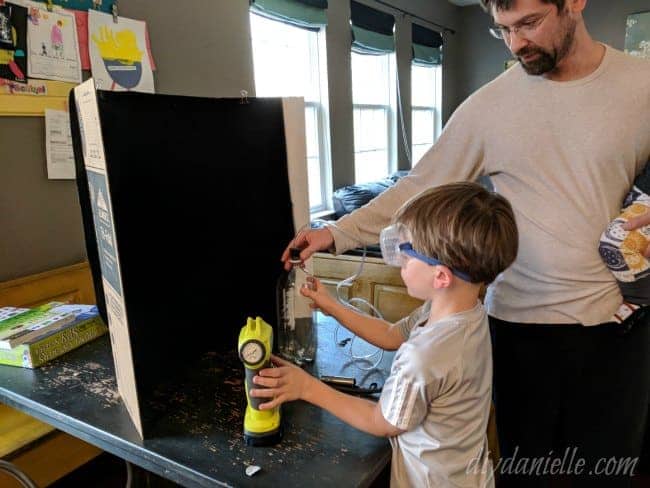
- Start a Garden: Gardening is an important task. It provides food to eat. You learn about how important water and sunshine is for growth. You learn how important it is to weed in order to save nutrients in the soil for your crops. Want to get your kids really involved? Forget selling lemonade- let them grow their crops all summer and sell them lemonade stand style. Talk to them about the bugs in the garden. Look up information on those bugs. We talk about the important work of bees and their need for water, we rescue them from drowning, we talk about worms and what they do in our garden.Pick a particular fruit or vegetable to grow and learn about using library books. This year, we’ve focused on growing blueberries and have been working to learn about the acidic soil needed to grow them. But we also have been growing vegetables, apple trees, hardy kiwi, paw paw trees, grape vines, and a blackberry bush… all on less than 1/2 acre.This is a friend we found in our garden… it’s a baby praying mantis!
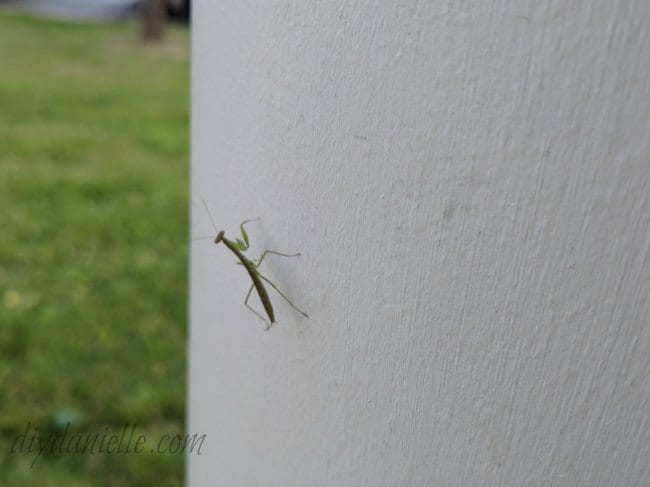
Summer Break Science: Educational Field Trips
Trying to take an educational field trip once a week or so is a good idea. Make sure to let it be an educational experience- read the information on the signs, answer the kids’ questions, and check out the special events where the staff talk to groups and answer questions.
- The Library! You’ll like the price tag on this one. It’s free. Head to the non fiction section and look for things your children are interested in. We like to read about bats, how things work, and astronomy. Of course, we also pick up some fiction. Our library also offers classes so keep an eye out for a library schedule.
- Local science centers. We have the Maryland Science Center which we have a membership too because it’s really fun and affordable. But we’re also close to Washington D.C. so we can hit up the Smithsonian museums for free. I LOVED Air & Space with the kids. The DoSeum and Morgan’s Wonderland in San Antonio are both awesome. And we also loved the Science museum in Dover, NH.
- Zoo: Lots of educational information is available at the zoo. They also sell memberships.
- Aquarium: Ditto to the above two.
- Go for a walk! Look for animals and trees and bugs. You can even bring a list of local flowers, trees, animals, etc to look for and identify. Make sure to look up how to identify poison ivy first though.
- Find local activities the kids are interested in: My kids are really into rocks and gems so last summer I was looking a local place to buy gems so we could make our DIY mining sluice (coolest project EVER). In the process, I found that we had an upcoming event at the Howard County fairgrounds, a Gem Fair that was held by the Gem Cutters Guild in Baltimore. When we attended, The Natural History Society of Maryland was there, showing butterflies and moths in different stages of metamorphosis. They have regular events where they’ll show you how to care for butterflies and even send you home with some to care for at home. We’re definitely hoping to attend some of their events this summer.
Pro Tip: Many memberships (for public sites like the zoo, aquarium and science center) are tax deductible! Save your receipts for tax season. Want to go while it’s quiet? Go after 1pm. The field trips usually are clearing out by 1 or 2 pm. I love the indoor museums for when it rains or is super hot.
Don’t forget to check out my post on Summer Break Reading!
Please pin this!
